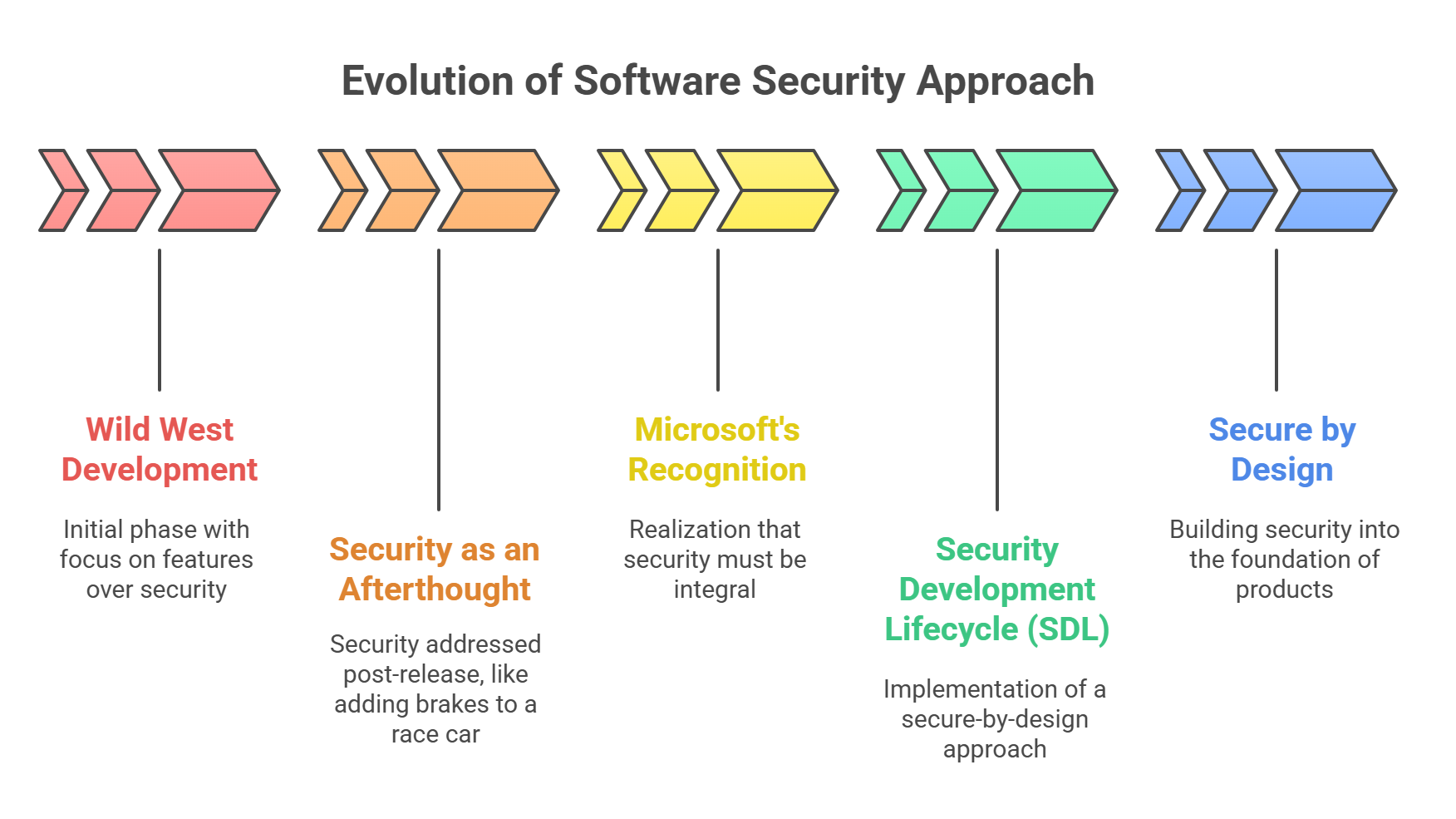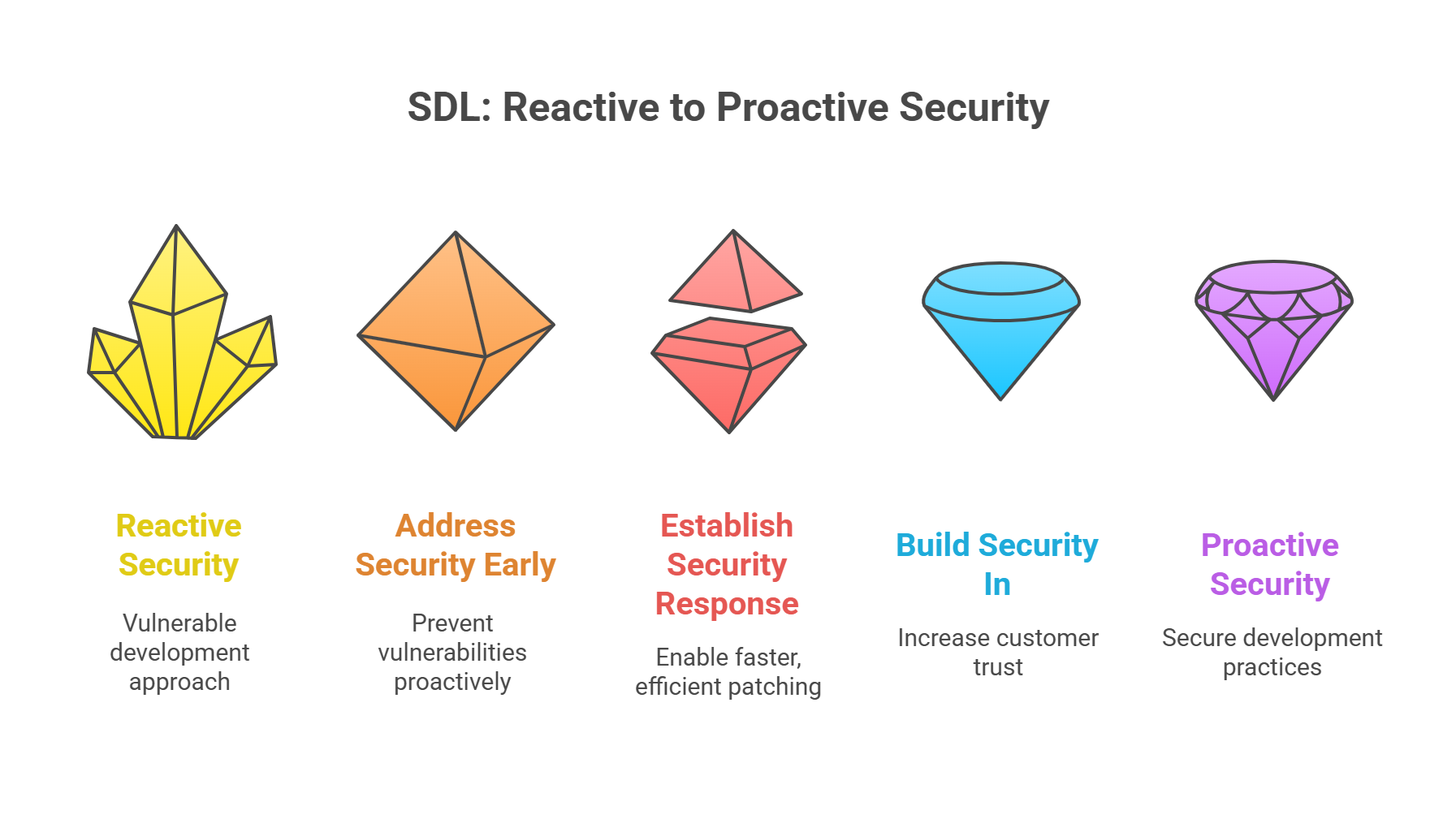
Leveling Up Before Launch: How Microsoft's Secure Development Lifecycle Turned "Oops" into "Awesome!" 🚀➡️🛡️
Alright, you've tackled threats, championed compliance, and even become a security MVP. Now, let's pull back the curtain and peek behind the scenes at how secure software is actually built. Forget the days of bolting on security like an afterthought (think adding a flimsy lock to a bank vault made of cardboard!).
Microsoft's Security Development Lifecycle (SDL) revolutionized the game, shifting security from a frantic "oops, we forgot that!" to a fundamental "let's build this thing right from the start!" Think of it as the ultimate blueprint for baking a security-infused cake, ensuring it's delicious and doesn't crumble under pressure! ➡️🔒
From "Patch It Later" to "Secure From the Get-Go": A Security Evolution ⏳➡️💡
Remember the Wild West days of software development? Features, features, features! Security often took a backseat, addressed only after a product was already out the door and potentially riddled with vulnerabilities.1 It was like building a race car first and then realizing, "Oh, maybe we should add brakes?" 😬 Not exactly the safest approach.
Microsoft recognized this needed a serious overhaul. They realized that security couldn't be an add-on; it had to be baked into the very DNA of their products. That's where the Security Development Lifecycle (SDL) came in – a game-changer that shifted the focus to "secure by design." It's like deciding to build a fortress from the strongest materials and with expert architects right from the foundation, rather than just hoping the walls don't fall down later! 🏰➡️✅

The SDL Secret Sauce: A Recipe for Secure Software 🧪
The SDL isn't just a vague idea; it's a structured process with specific stages and requirements integrated throughout the entire software development lifecycle – from initial planning to final release and beyond.2 Think of it as a detailed recipe with crucial steps to ensure a secure outcome:
Requirements: Knowing What "Secure" Looks Like 🧐: Before a single line of code is written, the SDL emphasizes defining security requirements.3 What are the potential threats? What are the security goals? It's like figuring out what kind of super-strong lock your fortress needs before you start building the walls.
Design: Architecting for Security 📐: Security considerations are baked into the design phase.4 Threat modeling becomes a key activity – proactively identifying potential vulnerabilities and designing mitigations.5 It's like having expert architects identify weak points in your fortress blueprints before any construction begins.
Implementation: Coding Defensively 💻: Secure coding practices are emphasized during development.6 This includes avoiding common vulnerabilities like buffer overflows and using secure APIs. It's like training your construction crew to use the strongest building techniques and materials.
Verification: Testing, Testing, 1, 2, 3! ✅✅✅: Rigorous security testing is conducted throughout the development process, including static analysis, dynamic analysis, and penetration testing.7 It's like having quality control inspectors constantly checking the fortress walls for any cracks or weaknesses.
Release: Secure Deployment and Ongoing Management 🚀: Even after release, security isn't an afterthought. The SDL includes guidelines for secure deployment and ongoing security updates and patching.8 It's like having a dedicated maintenance crew constantly monitoring and reinforcing your fortress.
Response: Handling Security Incidents Like a Pro 🚨: The SDL also includes processes for responding to security vulnerabilities that might be discovered after release.9 It's like having a well-trained emergency response team ready to handle any breaches in your fortress.

How the SDL Changed the Game: From Reactive to Proactive 🛡️➡️🚀
The adoption of the SDL has had a profound impact on the security of Microsoft products:
Fewer Vulnerabilities: By addressing security early in the development process, the SDL helps to prevent many vulnerabilities from ever making it into the final product.10 It's like catching potential diseases early, making the final outcome much healthier.
Faster Patching: When vulnerabilities are discovered, the SDL's established processes for security response enable faster and more efficient patching. It's like having a well-organized medical team ready to treat any illnesses quickly.
Increased Trust: Building security into the core of their products has helped Microsoft build greater trust with their customers. It's like knowing the company building your car prioritizes safety from the design stage.
Industry Influence: Microsoft's SDL has become a widely recognized and influential model in the software development industry, encouraging other organizations to adopt similar secure development practices. It's like a trendsetter inspiring others to build better and safer products.
The SDL Legacy: A More Secure Digital World for All! 🎉
The Security Development Lifecycle wasn't a magic bullet, but it was a fundamental shift in how software was built at Microsoft, with a ripple effect across the tech landscape. It's a testament to the idea that security isn't just a feature; it's a foundational principle. So, the next time you use a Microsoft product, remember the hidden work that went into making it more secure from the very beginning – all thanks to the SDL!
TL;DR: Microsoft's SDL: Baking Security into the Cake! 🎂➡️🛡️
Forget bolting on security at the end! Microsoft's Security Development Lifecycle (SDL) revolutionized software development by integrating security from the initial planning stages all the way to ongoing maintenance.11 Think of it as a recipe for secure software, with steps for secure design, coding, testing, and response. This proactive approach has led to fewer vulnerabilities, faster patching, increased trust, and a more secure digital world for everyone. It's all about building it right the first time! 🚀
 Add Row
Add Row  Add
Add 




Write A Comment